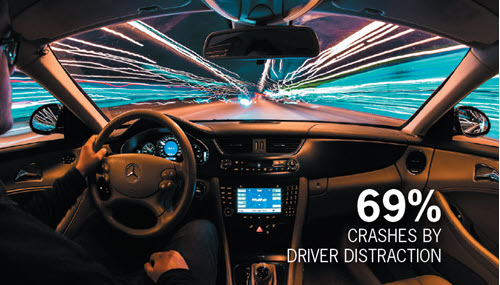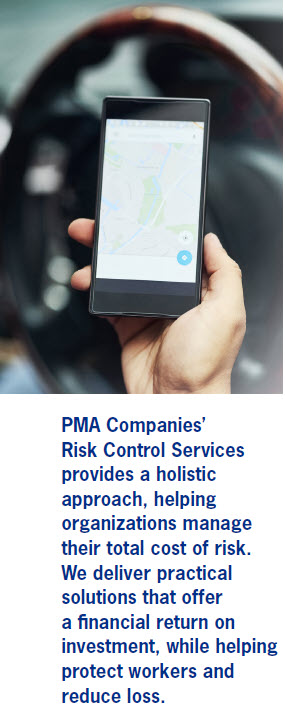Safety Awareness – Organizational & Safety Solutions for Driver Distractions
Posted on 04/04/23 by PMA Companies
Distracted driving habits of the motoring public are at epidemic levels. Driving while doing other things such as sending a text message, talking on a smartphone, using a navigational device, or eating while driving, has become a national pastime. Numerous surveys have confirmed that the overwhelming majority of drivers agree that distracted driving is a very dangerous practice, but almost all of those same drivers admit they drive while performing those tasks on a regular basis.
Reading or sending a text message can take your eyes off the road for about 5 seconds, long enough to cover a football field while driving at 55 mph. Distractions not only take your eyes off the road (visual distraction) but can also take your mind off the road (cognitive distraction) or hands off the wheel (manual). Many of the commonly practiced driver distractions often involve at least two of these.
The impact of drivers distracted with multitasking while operating a company vehicle has taken on additional meaning in recent years. There have been multiple multi-million-dollar court settlements involving at-fault drivers who were talking on their cell phones, text messaging, or using a laptop while driving. This technology not only allows device records to verify if the device was in use at the time of the crash, but also to pinpoint to whom the driver was speaking. In several of those cases, the court awarded additional damages to plaintiffs when it was determined the driver was on a business-related call.
Distraction Trends
Why has multitasking while driving become so widespread in recent years? Two key trends appear to be the primary factors:
1. People are using their phones in riskier ways. 85% of Americans now own smartphones, and they are taking advantage of their phone’s expanded technology for purposes other than making calls. In-vehicle camera studies show that drivers are more likely to be observed using phones to text, send emails, use social media, or to program navigational devices rather than for making phone calls.
According to a 2020 survey by the National Safety Council, 55% of drivers check social media while driving, which has led to the question: “Has social media while driving become the new texting?” Some especially dangerous social media driving distractions included the nearly 20% of drivers who admitted taking and posting photos and videos while driving.
Drivers are also increasingly using their smartphones as their GPS. Camera studies revealed the average time to program a navigational device while driving is close to 40 seconds.
Manipulating a phone while driving, as opposed to simply talking on the phone, leads to an even greater chance of a crash. According to a 2019 AAA study, any “visual-manual cell phone interaction” nearly doubles the odds of a crash, triples the odds of driving off the road, and increases the odds of rear-ending another vehicle by more than seven times.
2. Work pressure demands. According to employer surveys, the universal skills most sought by employers include multitasking, adaptability, problem solving, and computer and technical skills. If you place an employee with these skills inside a vehicle, multitasking while driving may occur. In the 2020 National Safety Council survey, 46% of drivers admitted that work pressure demands led them to use their phones while driving.
Numbers of Distracted Driving Crashes are Greatly Understated
Several of the prominent government-funded transportation safety agencies, whose data and statistics rely only on police-reported crash information, continue to assert that about 25% of crashes are caused by driver distraction. In defense of these agencies, their tally of mobile phone-related deaths is only as good as the data received from individual states, each of which has its own methods for diagnosing and detailing the cause of a crash. Each state in turn relies on its various municipalities to compile crash metrics—and they often do things differently, too.
The data from each state is compiled from accident/crash reports filed by local police, most of which don’t prompt officers to consider mobile phone distraction as an underlying cause. Only 11 states use
reporting forms that contain a field for police to tick-off mobile-phone distraction, while 27 have a space to note distraction in general as a potential cause of the crash.
In what was to become the first of many such studies, cameras and sensors were installed in 100 vehicles in 2006 to observe 241 primary and secondary drivers for more than a year. Researchers were able to observe more than 42,000 driving hours and more than 2 million miles of travel.
During this research, the 100 vehicles were involved in 82 crashes and 761 near misses. Camera and sensor analysis revealed:
- 80% of the crashes involved the driver looking away from the forward roadway just prior to (within 3 seconds) the crashes
- Drivers were distracted by secondary activities 30% of the time while driving
- Fatigue (cognitive) contributed to 12% of the crashes
- Distracted drivers experienced a 25% delay in responding to a change in speed of the vehicle in front
- 93% of the rear end crashes involved the driver looking away from the roadway within 3 seconds of the crashes
- A typical distraction lasted 3 seconds (long enough to drift into other lanes or to travel 300 feet at 68 mph) and usually increased crash chances 3-4 times
- Text messaging took the driver’s eyes off the road 4.5-6 seconds, and increased crash chances 23 times
These conclusions have been consistently reinforced by numerous subsequent studies conducted by a wide array of safety organizations. The studies led the National Highway Traffic Safety Administration to amend their long-held accidents/crashes-caused-driver distraction statistic; they now state that driver distractions are a factor in 69% of vehicle crashes.
Distraction "Hangover"
Studies undertaken in recent years have also revealed a distraction “hangover” effect: a driver is still cognitively impacted (hangover) 15-30 seconds after the distraction activity has ended. These studies were initiated after researchers continued to see increased levels of poor driving behaviors, such as hard braking events, after the distraction. The length of the hangover can differ by the type of the distraction. A study by the University of California Institute of Transportation Studies showed that a hangover after a text distraction lasted 36% longer than an electronic voice distraction.
Hands-Free is Not the Answer
When the scope of the distracted driving problem first became apparent, the communications and automotive industries scrambled to come up with alternative devices and systems that were touted
to be safer than the traditional hand-held cell phone. This led to the development and release of hands-free devices ranging from cell phones using Bluetooth technology, to in-vehicle systems that allowed phones to be synched in to the vehicle audio systems.
The first truly credible study on the safety of hands-free devices was conducted by the Virginia Tech Transportation Institute (VTTI) in 2013. The study involved the use of in-vehicle cameras to monitor
drivers using hands-free devices. The study concluded that drivers using hands-free devices either had their hands on the device or their eyes on the device 43% to 65% of the time. In the concluding report,
VTTI stated that hands-free devices were not a safe alternative.
Following the VTTI study, all transportation safety agencies and groups reached the same conclusion. Campaigns such as the National Safety Council’s “Hands-free is not risk-free” are an accurate reflection of the safety industry’s disdain for hands-free devices. Vehicle negligence lawsuit verdicts have also asserted that handsfree devices are not a safe alternative. In 2012, a Texas jury awarded $21 million in damages to a woman who was struck by a Coca-Cola driver who was using her company-supplied hands-free cell phone at the time of the crash. The plaintiff’s attorneys successfully argued that Coca-Cola’s cell phone policy was “vague and ambiguous” and said the company knew the dangers of hands-free cell phone use, but “withheld this information from its employee driver.”
Currently 27 states and the District of Columbia ban the use of hand-held phones while driving, and 6 other states ban the use of hand-held phones in areas such as school zones and work zones. 48 states ban texting while driving.
Effective Actions to Reduce Distracted Driving
- Review all work-related responsibilities for drivers. This may require driver ride-alongs to capture driver feedback adequately. Ask yourself, “does our work culture not only encourage but also pressure drivers to multitask, especially with electronic devices while driving?”
- A clearly worded written policy communicated to employees upon hire and on a regular basis thereafter. The policy must list the behaviors that are not allowed along with the specific disciplinary procedures to be undertaken when the policy is violated. Employers must begin to think of vehicles as a work environment.
- Track all vehicle incidents and calculate the rate of crashes per miles driven. Set corporate goals for lower rates and publicize goal progress to all drivers on a regular basis.
- Drivers should obey all appropriate federal, state, and local laws regarding the use of electronic devices. To find out more about laws in your area for cell phone use and texting while driving, visit the Governors Highway Safety Association website.
- The use of any electronic device while driving should be prohibited. Drivers wishing to participate in a phone call should pull off into a parking lot or a rest area.
- Employers should limit phone calls to drivers during their shift. If a call must be made, managers should make it clear the driver is expected to get off the road to participate in the call.
- Utilize available resources that enhance the ability to interact proactively with drivers before crashes and/or violations occur, including:
- Driver Monitoring programs - These programs include effective quality assurance controls, such as callers that call in about a monitored driver and are required to provide decal numbers, exact locations, and time-of-day.
- DriveCam - This program provides real-time image of the inside of the vehicle (pointed at the driver), an image of the roadside ahead (pointed out the windshield), and the use of electronic devices to provide exact location, speed, and RPMs.
- In-vehicle monitoring systems - These “vehicle black box” data collection and analysis systems are primarily GPS-based and can instantly identify vehicles that are in motion while the driver is on a cellphone call. Additionally, these systems can monitor an array of driving behaviors, such as hard braking, which can be an indication of a distracted driver. Program administrators can receive an immediate text or email notification.
- Mobile Apps to detect distracted driving - These apps, many of them free, can be loaded onto smartphones, and used to monitor phone use, speed, and certain driving behaviors.
- Crash Mitigation Systems for vehicles - Signs of possible driver distraction include hard braking, the vehicle drifting out of its lane of travel, and collisions/near collisions with vehicles in blind spots when attempting to change lanes. Examples of crash mitigation systems to address these behaviors include forward collision warning, emergency braking, lane departure alarms, and blind spot detectors and alarms.
Note: Please refer to the Organizational Safety Solutions Bulletin, Driver Monitoring Programs, for more information on resources listed above.
IMPORTANT NOTICE
The information and suggestions presented by PMA Companies in this risk control technical bulletin are for your consideration in your loss prevention efforts. They are not intended to be complete or definitive in identifying all hazards associated with your business, preventing workplace accidents, or complying with any safety related or other laws or regulations. You are encouraged to alter the information and suggestions to fit the specific hazards of your business and to have your legal counsel review all of your plans and company policies. PMA Companies and Old Republic Companies do not provide legal advice and the information and suggestions in this bulletin should not be considered as such.

